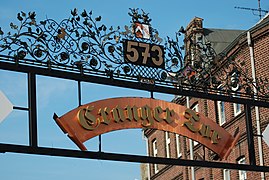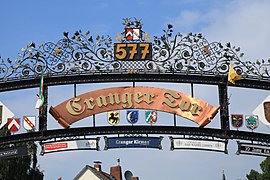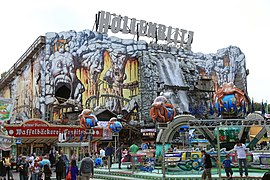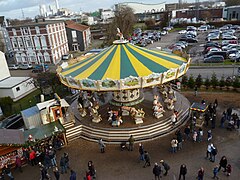Cranger fun fair
The Cranger fair is a popular festival in Herne district Crange . With an average number of visitors of around 4,000,000 in recent years, it has been one of the largest folk festivals in Germany. According to police reports, 4.7 million people came to the fairground on the Rhine-Herne Canal in 2008 .
history
The origins of the Cranger Kirmes are largely unknown. All theses that have been published and discussed for over a hundred years are more or less likely speculations.
The first verifiable mention of the Cranger Kirmes can be found in 1703 in an order from the royal Prussian government in Kleve to establish the right to hold a fair as claimed by Mr von Rump zu Crange. In this document it says, “that von Rump has established an old and two-century possession and right of a year to keep on a Sunday”. The approximate time in this document thus refers to a fair tradition that goes back to around 1500.
The origin of the fair is probably a few decades earlier. It is often said that the fair can be traced back to an "ancient" horse market. In fact, wild horses have been recorded in the Emscherbruch since 1369 . According to the literature, the horses, also called Emscherbruch Dickköppe , were in demand for their toughness and endurance and have achieved top prices. Regardless of this, a horse market for this time is not documented. Corresponding claims in the older literature, which later authors used again and again for orientation, are not supported by any evidence.
The first verifiable date in Cranger history comes from the year 1441. Derick von Eickel was enfeoffed with House Crange by his liege lord, Duke Adolf von Kleve , Count von Mark, on August 10, 1441, Laurentius Day. In 1449 he received from the Roman Curia the special right to "own a portable altar in order to be able to celebrate Holy Mass (...) in Haus Kranghe or in other chapels (...)." As a thank you, von Eickel had the Laurentius Chapel built. When the chapel was completed and consecrated, however, is again not documented. The inauguration of the chapel as the beginning of the tradition of the Cranger Kirmes appears to be entirely plausible, as the word Kirmes etymologically comes from the Middle High German “kirmesse”, shortened from Kirchweihmesse. In newspaper reports from the beginning of the 20th century, the origin of the fair as a “parish fair” is repeatedly pointed out. In a document from 1484, the "Freedom Crange" is mentioned for the first time, which basically implies a market right.
The approach to the origin of the Cranger Kirmes is probably only possible through the interaction of the documents that have been handed down. Based on the approximate time in the above-mentioned trial file of 1703, the assessment results that the fair probably took place in the period from 1449 (decree of the Roman Curia, which resulted in the chapel first documented in 1526 being built) to 1484 (Freedom Crange with the existing Market law). The parish fair must be seen as the foundation of tradition, and a horse market was added to accompany it. Whether horses have already been traded before cannot be ruled out any more than it can be verified. There are no documents on this. The last horse market at which wild horses from the Emscherbruch were sold took place after Napoleon's regional reform . In contrast to the fair, it lost more and more of its importance. This grew year after year in parallel with the emergence of industry and mining in the Ruhr area .
The counting of the Cranger Kirmes was set arbitrarily by the National Socialists in 1935 in order to use the festival for propaganda purposes. With great effort and with the involvement of all party organizations and the city administration, the anniversary fair was held in 1935 with a wide range of special events. Some of them like the official opening ceremony, the historical horse market and the pageant have since been part of the standard repertoire of the fair program. At the fair itself, the NSDAP held back with ideological program items and open NS symbolism. The people should celebrate and experience themselves casually as the "living embodiment of the idea of the national community". The foreword of the anniversary brochure published by the city of Wanne-Eickel and the district leadership of the NSDAP also said: “This also gives the meaning and purpose of the folk festival for the 500th anniversary of the village of Crange and the Cranger fair. May the festive season go well and contribute to the people gathering all their strengths for a joyful commitment to the new Germany and its leader. "
Since the dating was completely untenable, it was dropped after the war. It was not until 1990 that marketing experts resorted to the Nazi era. With the schnapps number “555. Cranger Kirmes ”, the folk festival of the Ruhr area was to be positioned prominently in competition with other fairs in the Federal Republic. For the first time, the number was inserted on the Cranger gate. Since then, the number of fair fairs that have taken place has been written on the Cranger fair gate every year; in 2015 the "580th" fair took place. On February 19, 2019, the city of Herne announced that it would use a different way of counting the Cranger Kirmes in future, based on the first documentary mention of the Freedom Crange with implied market rights in 1484. For this reason, the 584th, but the 535th Cranger Kirmes took place in 2019.
The fair mascot "Fritz" was introduced in 1996. The stylized pit pony with yellow hard hat and red head lamp , designed by Dietmar Kremer on behalf of the city of Herne, as well as the varying annually pins . In 1997 a 1.60 m high and 400 kg heavy bronze figure was set up at the end of the main street, the main entrance area of the fair. There are also other crange and fairground motifs that are marketed on merchandising products.
Size dispute
Almost traditionally, residents and fans of the respective events and cities argue about the title of the largest folk festival in Germany or the largest folk festival in North Rhine-Westphalia . Since the dimension “size” naturally cannot be precisely defined, it is possible, depending on the calculation basis , to award the title to the Munich Oktoberfest , the Cannstatter Wasen , the largest fair on the Rhine in Düsseldorf or the Cranger fair.
The values of the four largest folk festivals in Germany:
| Surname | Area (in ha) | Number of visitors (2006, in millions) | Duration (in days) | Visitors per day (in millions) | Visitors per m² | Visitors per day u. m² |
|---|---|---|---|---|---|---|
| Cranger fun fair | 8.3 (11) | 4.5 (4) | 11 | 0.45 (0.40) | 54 (36) | 5.4 (3.6) |
| Munich Oktoberfest | 31 | 6.5 | 16 | 0.41 | 21st | 1.3 |
| Cannstatter Wasen | 35 | 4.2 | 17th | 0.26 | 12 | 0.7 |
| Largest fair on the Rhine | 17th | 4th | 10 | 0.44 | 24 | 2.4 |
Values Cranger Kirmes according to the police, values of the organizer in brackets
If you look at the value for “visitors per m²” at the Cranger Kirmes and do a rough calculation, you get 4 to 6 visitors per day and square meter at peak times. Critics who have already visited the fair themselves unequivocally admit the title “most crowded folk festival in the world”.
Location
The Cranger Kirmes is located directly on the Rhine-Herne Canal on the former site of Shaft 5 of the Unser Fritz colliery and is accessible via the A 42 (exits Herne-Crange, Herne-Baukau or Herne-Wanne) as well as public transport via Wanne -Eickel Hbf , Herne Bf and Gelsenkirchen Hbf and the public transport connections there (shuttle buses to all train stations) can be reached. During the fair, the White Fleet runs on the Rhine-Herne Canal from Oberhausen via Essen and Gelsenkirchen to the fairground .
The Cranger Kirmes fairground is over 83,000 m² in size and has over 5 km of stall front. There are souvenir stands, lottery booths and food stalls everywhere. Around 400,000 visitors come to the fair every day. In addition to the square itself, some streets in its vicinity are being built with stalls and rides. According to the city of Herne, the total area of the fair, which is formed by over 500 showmen, is 110,000 m².
Date and program
The 583rd Cranger Kirmes 2018 started again on the first Thursday in August and lasted a total of eleven days. In 2011 and 2012 the fair was extended to eleven days and started on Thursday evening. As a result of a complaint by a local resident, the fair started again on the first Friday in August from 2013 and therefore lasted only ten days.
Before the opening of the Cranger Kirmes, the horse market takes place the day before (Thursday). Furthermore, the fair fans celebrate a warm-up party on the evening of that day on the fairground in the marquee “Glück auf Crange”. On Friday afternoon at the beginning of the fair with miners' band, the President of the German Showmen Association welcomes the flag delegations of the showmen's associations in the marquee. The Cranger Kirmes will then be opened by the incumbent Lord Mayor of the city of Herne with the exclamation “Piel op no Crange!” And the traditional tapping of the keg , followed by an address by the guest of honor and the performance of the invited artists.
On the following Saturday a big parade starts from Eickel towards the fairground. Wednesday has been a family day for many years, on which the showmen offer reduced prices, but the driving and gourmet passes are not valid on this day. In the Cranger Church , the short devotion "15 minutes for God" takes place on every day of the fair at 7:30 p.m., alternately held by both denominations. On the last day of the Cranger Kirmes (Sunday) there is a big fireworks display.
At the 573rd Cranger Kirmes in 2008, 4.7 million visitors were counted; the highest number of visitors so far.
The around 50 rides , show and run shops include carousel variants such as chain carousel , Tagada , mountain and valley railways , propellers and pinball machines , free-fall towers like the hangover , afterburner like the Konga , high round rides , round rides like breakdance , as well as bumper cars , air - and swinging ship , Ferris wheel , roller coasters like the Wild mouse , flume ride , themed rides , haunted houses , rollover swings , Boxbude , well run businesses such as mirror maze and laughter cabinet .
Cranger Christmas magic
At the Cranger Kirmesplatz, a combination of a winter fair and a Christmas market takes place under the name Cranger Christmas Magic on an area of around 25,000 square meters. One of the largest mobile Christmas trees in the world stands on the square at a height of 45 m. In the lower part of the 80-ton artificial fir tree, which is illuminated by two million LED lamps , there is a two-story restaurant. In addition to rides, other attractions include Christmas market stalls, a fairytale forest , petting zoo and an all-day ice rink . After the opening, there will be several Christmas performances and shows for children until the end. In order to appeal primarily to the family audience, the event ends every day at 10 p.m. The music on the square is controlled centrally and consists of Christmas pieces.
For the first time, the event took place from November 23 to December 31, 2018. This included three large restaurants and an amusement park with rides, such as Konga , Wellenflug chain carousel , ghost train , wild mouse and ferris wheel . The event ended with a New Years Eve party and fireworks. There was criticism in advance, as some residents feared annoyance from arrival and departure traffic, noise and drunken party guests. The second edition of this event took place from November 21st to December 30th, 2019.
In contrast to the Cranger Kirmes, the organizer is not the city of Herne, but the Cranger Weihnachtsveranstaltungs GmbH & Co. KG with the showman Sebastian Küchenmeister as managing partner.
literature
- Waltraud Turkowski: The Cranger Kirmes: origin, development and today's importance. Society for local history Wanne-Eickel eV, 1989; ISBN 3-936452-01-6
- Annette Krus-Bonazza: At Cranger Kirmes: from the horse market to the Oktoberfest des Westens , contributions to folk culture in Northwest Germany, no. 80, Münster, Coppenrath 1992 ( full text as PDF )
Web links
Individual evidence
- ↑ A reproduction of the letter is in the Herne City Archives. Original: Gräflich von Spee'sches Archiv Ahausen, files, inventory Crange
- ↑ Devens, Friedrich Karl: The German horse in history, in Sitte, Sang and Sage. Leipzig undated
- ↑ See in particular: Hegler, Gustav: Eickel-Wanne, once and now. History of the two offices. Siegen, 1903. (The postman Hegler, who is interested in local history, only repeats the remarks by Friedrich Karl Devens, see previous footnote.)
- ^ Copy of the document in the Herne City Archives
- ↑ See: Stadtarchiv Herne: Collection of newspaper clippings Cranger Kirmes, 1900ff.
- ↑ Quoted from: Ralf Piorr (eds.) Herne and Wanne-Eickel 1933-1945. A historical city guide, adhoc Verlag, Herne, 2013, p. 111ff.
- ↑ See: Krus-Bonazza, Annette: "Auf Cranger Kirmes". From the horse market to the Oktoberfest des Westens, Münster 1992. (The standard work on the history of the fair offers a profound examination of the topic, but is hardly received in popular literature and in political discussion.)
- ↑ http://www.cranger-kirmes.de/crange-home/einzelansicht/article/neue-zaehlweise-fuer-die-cranger-kirmes.html
- ↑ InHerne - the city magazine: "That was an honor for me" - Interview with the creator of the fairground mascot from August 2, 2018. Accessed on October 23, 2018
- ↑ Line trips on the Rhine-Herne Canal to the Cranger Kirmes ( memento of the original from June 26, 2010 in the Internet Archive ) Info: The archive link has been inserted automatically and has not yet been checked. Please check the original and archive link according to the instructions and then remove this notice. Retrieved August 14, 2010
- ↑ Quiet point in the funfair bustle , WAZ August 12, 2017
- ↑ Press release on waz.de 2008
- ↑ Stadtmarketing Herne: Rides for the 583rd Cranger Kirmes from August 2 to 12, 2018 . Retrieved October 24, 2018
- ↑ Michael Muscheid: Herne receives the world's largest mobile Christmas tree on October 8, 2018. In: WAZ. Retrieved October 26, 2018
- ↑ Biggest Christmas tree: Dortmund faces competition from October 10, 2018. In: Radio 91.2 . Retrieved October 26, 2018
- ↑ Dortmund Christmas tree has competition from Herne on October 9, 2018. In: Local time . Retrieved October 26, 2018
- ↑ Michael Muscheid: Cranger Winterzauber: These are the most important facts from October 11, 2018. In: WAZ. Retrieved October 26, 2018
- ↑ Website for the winter fair: Attractions . Retrieved October 26, 2018
- ↑ Website for the winter fair: Shows . Retrieved October 26, 2018
- ↑ Winter fair in Herne causes a stir among residents. In: WAZ. Retrieved December 4, 2018 .
- ↑ aufcrange.de: Cranger Christmas Magic 2019 - The first information . Retrieved October 18, 2019
- ↑ Imprint Internet presence of the Cranger Christmas Magic. Retrieved December 4, 2018 .
Coordinates: 51 ° 32 '40 " N , 7 ° 9' 48" E




















